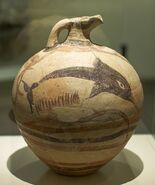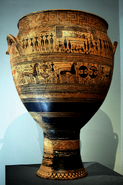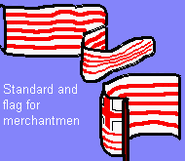A Forgotten Duchy in the Middle of Longerath[]
By Dr. Lukas Lueckenfueller, Institute for Studies of the Fenis
|
|
||
 Rock of the Moon, Cruisana, displaying the tribal name "FEN[I]S" |
Regional Prehistory and Early Events[]The clan of the Fenis emigrated from Mystgallia (modern Cruisana) before the 5th millennium BP and settled in northern Mokra, slowly spreading from the coast into the inland, bordered in the south by the river Oder separating them from the Lumattans and in the north by the Great Jumurian Desert. They reached the Central Longerathian Mountains in a first move, and later advancing till the Weissmont Mountains, thus occupying the Rosenvalley (part of modern Terrablanca in Dascunya). Their culture reached its peak in the early 5th millennium (stone temples, 5000 - 4500 BP) from which time stonemasonry and sculpture remained their special skills. It declined remarkably during the 4th millennium while the Gardlian culture rose and gained a determinant influence on the Fenis. In the early 3rd millennium (probably in the 29th century BP) the Fenis were subdued by the Gardlian Duke Thomas and his military aristocracy. |
 Stone temple on the Futuronian coast, early 5th millennium |
Crater, early 25th century BP, Phenia Museum, St. Paul Castle, St. Paul (TR), FSD | ||
 Fenis Battle Flag, 2580 BP  Duke Paul (+ 2540 BP), sculpture from 22nd century BP  Fenia in 2570 BP |
The Formation of the Reign of Fenia[]The Fenis, however, had retained an uncompromising tribal pride and therefore they could not bear the foreign rulership for long. Having little by little acquired the Gardlian military art and technique together with their culture, they finally were in possession of the necessary means to revolt aginst the Gardlies. Under the leadership of the legendary Duke Paul, they succeeded in driving them out of Mokra first (2580 BP), and then out of the whole Rosenvalley (2570 BP). This put the Gardlies under a certain pressure which made them turn south and attack the Klerencies and the Lumattans. The military success of the Fenis forged the Reign of Fenia (or, in Liliani, Regnum Phenia). Duke Paul was proclaimed first regent of Fenia in the capital town of the Rosenvalley (modern St. Paul in Northern Dascunya) and established his residence in the newly erected castle of Fena Pauli (lateron also known as Phena Oppidum or Phenapolis, modern Odesiuky), already an important harbour on the Futuronian coast, where he died in 2540 BP. The foundation of an own realm paved the way for a renewed cultural development which lead to another peak in stonemasonry and sculpture. The Fenian territory may have included the Depression of Hawadan which from 2038 formed part of Burburreica. In 1575 a small part of this area was re-integrated into the Reign. 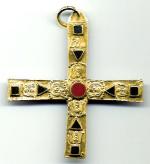 Gisulf's Cross, c 1100 BP, Archepiscopal Treasury, Odesiuky (Mokra) Cruisianity had begun to enter Longerath in the 15th century BP. When Liliana was declared a Cruisian nation by Emperor Constantinus (1376 - 1330 BP), Fenia followed this example. On 6th January 1295, Duke Edward appointed his younger brother Jacob first Archbishop of Odesiuky. |
 St. Paul Castle in the Rosenvalley (St. Paul, Northern Dascunya), oldest parts from 27th century BP, in the background the impressive Weissmont Massif  Fena Pauli Castle in Odesiuky (Mokra, Feniz), founded 2550 BP  Ruins of Phenapolis from the 25th century in Odesiuky |
Apollon, 2200 BP, Phenia Museum, St. Paul Castle, St. Paul (Northern Dascunya) | ||
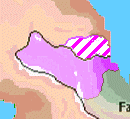 hatched: Area lost to Liliana around 1100 BP  hatched: County of Odesiuky broken away in 700 BP |
Fenia had always employed a self-confident but cautious and circumspect diplomacy and a well-trained army to maintain its political independence and territorial integrity. Fenis soldiers were even made available to the Liliani army where they served as élite formations. Later, in the 7th century BP, they were engaged as royal guards at the Dascunyan court in St. Hugues in Templarianna which is why they were called Templars. Fenian diplomacy included political marriages to an extent that made one poet write: «Bella gerant alii - tu, felix Fenia, nube!» Thus, Fenia had managed throughout its existence to withstand the territorial desires of its neighbours and even the great expansions of Liliana. Only when Liliana expanded for the last time (under Fovinius, 1155 - 1102 BP), Fenia lost a region less of importance in the northeast, namely the Great Fenizic Desert and an adjacent area towards the ocean.
400 years later, in 700 BP, the County of Odesiuky broke away from the duchy and joined the Union of Counties of Phenixia to which Fenia - irony of fate - had lent its name. The harbour of Odesiuky had constituted Fenia's only access to the open sea. Its defection cut off the vital overseas trade routes. In the long run, this proved crucial to Fenia's existence. |
 Templar as funeral guard at the burial of King William I of Dascunya, 679 BP |
|
Fenian ships with standards and flags, table paintings from the St. Paul's church, St. Paul, 8th century BP | ||
 Duke Guinfred, miniature book painting, c 560 BP  Bulla Paulina: Splitting-up of Fenia in 600 BP: |
The End of Fenia[]During the next hundred years, the economic situation aggravated more and more. In 600 BP, Fenia's economy collapsed. To avoid a famine, Guinfred, the last Duke of Fenia, was forced to accept the Bulla Paulina or Agreement of St. Paul which split up and distributed Fenia among its neighbours Phenixia, Dascunya, and the newly erected Empire of Estontetso, successor to Liliana. Phenixia received a region in Mokra rounding off its possessions, Dascunya got the southern Rosenvalley and contol of the Central Longerathian Mountains, and Estontetso took over the northern Rosenvalley including the emotionally important St. Paul. Emperor Natestus (662 - 600 BP) of Liliana and now of Estontetso allowed Guinfred to continue governing this portion - "last remain of vast a reign" as the poet Walter of Birdmeadow nicely put it - under Estontetsan supremacy as he had promised in remembrance of Fenia's former fidelity. After Guinfred had died in 580 BP, however, Natestus' successor ceded that last remainder and reminder of Fenia to Dascunya. Guinfred was buried, according to his last will and with the consent of Phenixia, in the cathedral of Odesiuky, the historic burial-place of so many of his predecessors. Buried with him was the Reign of Fenia which had lasted 2000 years. The Fenis Ethnicy[]Despite the dissolution of their state, the Fenis continued to form an ethnic group of firm coherence, with a seemingly Gardlian-Cruisian culture. The Rosenvalley, region of their traditional if not mythical affection, belonged completely to Dascunya, and enjoyed a relative autonomy under the name Terrablanca, derived from the Weissmont Mountains. To avoid the Plague, all the Fenis reunited when those from Phenixia retreated to their brethren into the Rosenvalley which indeed was secluded enough to give some shelter. After the Plague, the Phenixian Fenis tried to return to their inherited settlements but were trapped between the Hoch, the Iparalaspuqui and the [Lambucas/Burburreicans]. The Hoch (formerly known as Faeniccians or - even before - Lumattans) came from their own retreat in the Central Longerathian Mountains where they had formed, during the years of the plague, a common feeling and an own interpretation of Cruisianism, the Zbirna Solianka, and had already populated most of Mokra. Only a small number of Fenis were able to settle among them. The Iparalaspuqui, a foreign people from Armatirion, were populating the coastal region from the north on invitation from the Emperor of Estontetso. In the area south of Fenizabad they encountered the Fenis, and the settlements of both peoples mixed. The [Lambucas/Burburreicans] still lived in their inherited region where most of them had survived the Plague. There was no more room for any new settlers. Some of the Fenis did not get further than the Great Fenizic Desert and had to adapt themselves to a nomadic life in the desertuous region. During the Estontetsan civil war of 298 AP, many Fenis fled from the region (which was now Estontetsan) to the south (still Phenixia) and returned in what became known as the Green March. |
 Bulla Paulina (Agreement of St. Paul), 600 BP, National Archives, Kyjovo (Mokra, Feniz)  Odesiuky Cathedral (built 670 - 594 BP), Duke Guinfred's burial-place |
"The Wife Kills The Childhood", 20th century BP? |
The Fenis Today[]Today the Fenis form a sheikhdom (tribe) within the Sultanate of Feniz. They have been granted rights like an emirate, thus honouring their continued political importance. Despite their considerable population and the age of their culture, they have not, however, been able to impress the Fenizic culture which is dominated by the Iparalaspuquis. The Cruisian Archbishop of Odesiuky, the office of whom exists for 1600 years, is nowadays looked upon as a focal point of Fenis tradition. |
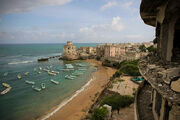 Modern Odesiuky |
TECH: []
TECH: Under construction! Remaining questions: []
- Kjell: Are you contented with Mounism coming from Rimlah?
- Thomas R.: Is there a possible influence (or - preferrably - lack of infuence) of Klerencies and Odemoss?
TECH: Credits []
- Title map, archbishop's flag © 1999 Edward Mooney Jr.
- Original historic maps © Thomas Robinson
- Green march flag © Philippe Bondurand
- "The Wife Kills The Childhood" © Otto Lohmüller

